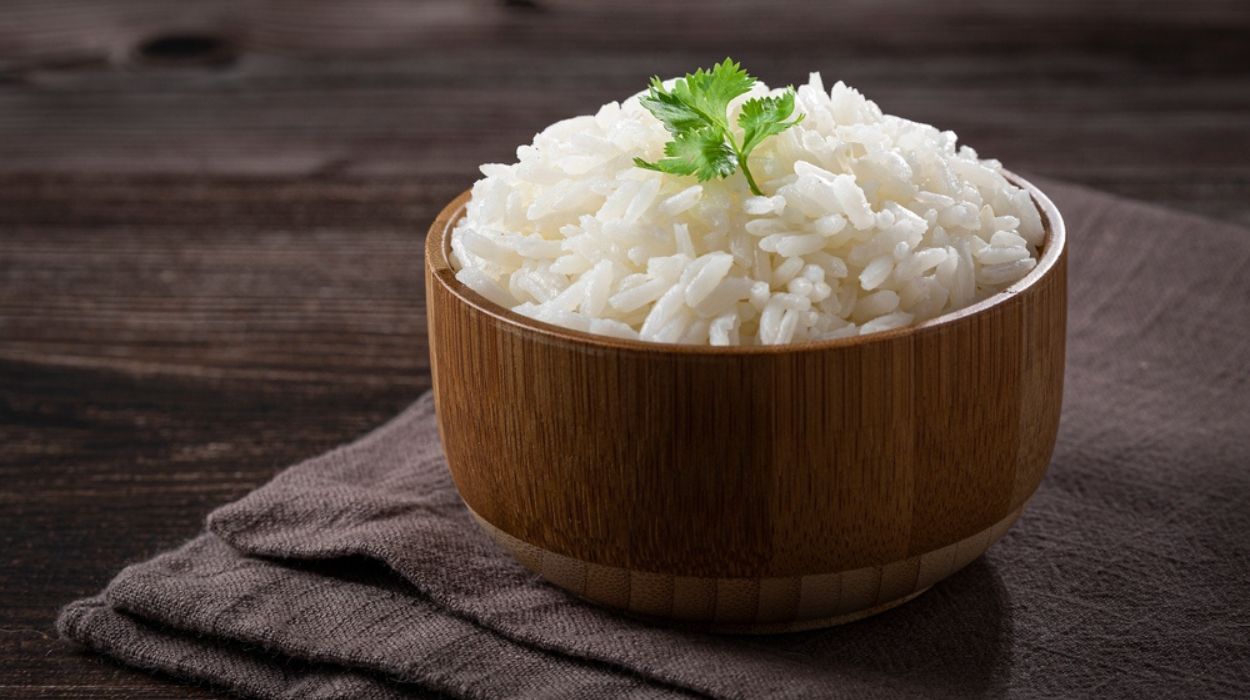Carbs are often seen as the enemy when it comes to losing weight. Unfortunately, we’re often led astray and told to avoid all carb foods, whether they’re simple or complex carbohydrates. Yet, the human body requires all three macronutrients, including protein, fats, and carbs, to function optimally.
The truth is you can enjoy many carbs, including jasmine rice, as part of a balanced diet. Yet, is rice good for weight loss? And, more specifically, is jasmine rice good for weight loss?
Below, we explore what jasmine rice contains and how it fits into your goals of achieving a healthy weight.
Is Jasmine Rice Good For Losing Weight?
Whether Jasmine rice is good for weight loss depends on several factors. Jasmine rice can be enjoyed in moderation as part of a healthy weight-loss diet. However, consuming too much or exceeding your daily caloric needs may lead to weight gain. At the same time, no evidence links rice consumption alone to weight gain or difficulty losing weight. Often, other factors play bigger roles, such as total caloric intake or lack of physical activity.
Is Jasmine Rice Good For Weight Loss?

Jasmine rice is a long grain and Thai fragrant rice. As this suggests, it’s commonly grown in Thailand and consumed in many traditional dishes.
Research shows that 41% of the United States population was obese[1] in 2017-2020. That is a hefty problem.
Thus, there might be something to this rice that contributes to easy weight management. So, is jasmine rice good for losing weight? This might depend on the type of jasmine rice consumed.
There are two types of jasmine rice: white and brown. However, brown jasmine rice might boast more benefits and nutrients that are relevant for weight loss, notably fiber.
Depending on the source, a serving of brown jasmine rice is from one-fourth to one-half cup. This translates to 100 to 125 grams of cooked brown jasmine rice. However, these numbers vary according to the source and whether the rice is uncooked or cooked.
For our purposes, one 100-gram serving of cooked brown jasmine rice[2] offers about four grams of fiber. Eating more fiber is associated with increased weight loss.[3] So, let’s briefly explore how fiber might prevent weight gain and the health benefits associated with it.
Fiber Can Increase Feelings Of Fullness
Research links dietary fiber to increased satiation and better appetite regulation.[4] This is largely because fiber, when combined with water, forms a gel-like substance in the gut. This, in turn, slows digestion, keeping you full for hours afterward.
The sheer weight of the gastric contents distending the stomach also messages the brain of fullness via the satiety hormone leptin.[5] For many, this may mean they are less likely to snack in between meals or consume excess calories in one sitting. Overall, eating more fiber could lead to eating fewer calories, which contributes to weight loss.
Fiber Improves Gut Health
Digestive health is key to healthy weight loss. When imbalances occur in the gut, this can lead to widespread inflammation and the development of metabolic diseases.[6] In contrast, research shows that a healthy digestive system and gut microbiota can play a role in alleviating metabolic diseases and obesity.
So, where does fiber come into the picture?
Well, high fiber intake is linked to reduced gut inflammation.[7] Jasmin’s insoluble fiber has been shown to increase stool frequency and consistency[8] without any adverse effects. Regular bowel movements signify good gut health.
Soluble fiber, on the other hand, helps lower cholesterol. Jasmine does have some soluble fiber, but the insoluble fiber predominates.
On top of the above, dietary fiber plays a role in maintaining the health of the gut microbiome.[9] Fiber is fermented by the bacteria in the gut, which produces short-chain fatty acids. These fatty acids are further associated with activating the release of leptin[10] from fat tissue, which helps suppress appetite.
Fiber May Enhance Energy
High glycemic foods, like rice, often lead to blood sugar spikes and dips. This is particularly true if they contain low fiber and aren’t consumed alongside protein and fat. Yet, foods high in fiber lead to a lower glycemic response.[11]
Maintaining stable blood sugar levels is important for stable energy, particularly in women.[12] It’s also important for reducing cravings,[13] which may go hand-in-hand with feelings of fatigue. Fewer cravings may lead to fewer calories eaten throughout one’s day, which can contribute to weight loss.
Fiber May Reduce The Risk Of Heart Disease
Obesity is a major risk factor for heart disease.[14] However, research suggests that adequate fiber intake may alleviate this risk,[15] including reducing the risk of cardiovascular disease, coronary heart disease, and stroke.
This same research further shows that fiber impacts cardiovascular health by reducing total serum and low-density lipoprotein cholesterol concentrations. Thus, including more fiber in your diet doesn’t just potentially lead to weight loss but also overall better health.
Fiber May Contribute To A Healthy Immune System
70 to 80% of immune cells[16] are found in the gut, demonstrating the importance of a healthy microbiome for a healthy immune response. As per any system in the body, none of them function in a vacuum. Since fiber can help support a healthy gut, it can, in turn, improve immune health and potentially lead you to get sick less often.
Fiber in brown jasmine rice can play a part in healthy weight loss, but it’s important to consider total caloric intake. A surplus in calories can lead to weight gain.
Another piece here is to consider your entire lifestyle. Turning to a weight loss supplement or fat burners won’t necessarily contribute to sustainable and healthy weight loss. Rather, this takes a holistic approach involving a healthy diet, regular exercise, and reduced stress.
The Nutritional Value Of Jasmine Rice
Jasmine rice is, arguably, one of the better rice varieties. More specifically, brown jasmine rice can offer plenty of nutrients and potentially help you to lose weight. So, let’s look at white jasmine rice vs brown jasmine rice.
What makes jasmine rice so great? With a good amount of nutrition, jasmine rice has plenty to offer.
One 100-gram serving of brown jasmine rice[2] contains:
- 160 calories.
- 3.2 grams of protein.
- 4 g of fat.
- 26.4 g of carbs.
- 4 g of fiber.
- 0.8 g of fatty acids.
One 100-gram serving of white jasmine rice[17] contains:
- 225 calories.
- 3.75 grams of protein.
- 0.62 g of fat.
- 48.12 g of carbs.
- 1.2 g of fiber.
- 12 mg of calcium.
- 0.23 mg of iron.
All around, jasmine rice is high in protein and fiber, especially when compared to regular white rice.[18] Brown jasmine rice offers slightly more fiber than white. Yet, white jasmine rice provides a bit of calcium and iron, which the brown type doesn’t contain.
Many types of rice aren’t often considered healthy foods, but this aromatic rice can be enjoyed in moderation alongside lean protein and vegetables. So, with that in mind, let’s dive into how you can incorporate this type of rice into your weight-loss diet.
How To Cook And Eat Jasmine Rice For Weight Loss?

Jasmine rice is a staple food in Asian cuisine, particularly Thai food. In the following sections, we look at how to cook jasmine rice and how you can incorporate it into a healthy diet.
How To Cook Jasmine Rice
Perfect jasmine rice is easy to master. Often, it comes down to the right water-rice ratio. Here’s how to make it:
- Boil 2 ¾ cups of water.
- Stir in 1 ½ cup of jasmine rice and a bit of salt.
- Cover the pan or pot, reducing the heat to low.
- Allow it to simmer on low for 15 minutes.
- After 15 minutes, try the rice to see if it’s done. It should be soft. If too firm, add a couple more tablespoons of water and continue simmering for a couple of minutes until soft.
Cooked jasmine rice can also be safely frozen in the freezer for up to three months. To reheat it after freezing, add a couple of tablespoons of water and warm it in the microwave.
Alternatively, jasmine rice can also be made in a rice cooker. Use the ratio of 1 ½ cups of water per one cup of jasmine rice for this method.
How To Enjoy Jasmine Rice
Some of the best ways to enjoy cooked jasmine rice are in chicken curries or stir-fries. Other ways may further include:
- Eat it alongside veggies and lean protein, such as chicken.
- Add it to a mixed greens salad.
- Have it in a burrito or wrap.
- Mix spices or herbs, like barely or parsley, into the rice.
- Add to your favorite soups, such as chicken noodle soup.
- Stir it into chilis or stews.
- Make homemade granola bars.
- Enjoy it as rice porridge.
- Make jasmine rice pudding.
Conclusion
So, is jasmine rice healthy for weight loss? It is an excellent choice of rice, but like all things centered on moderation, the answer is it depends.
Consuming too much rice and not enough of the other two macronutrients may lead to dysfunctions and imbalances. Yet, incorporating this delicious grain in moderation can work for most healthy weight-loss diets. Plus, there are many different ways to enjoy it, such as in curries, stir-fries, salads, granola, soups, and more.
Additionally, brown jasmine rice, in particular, may be a good alternative to regular rice. Yet, the best rice for weight loss depends on what you enjoy and what fits into your daily caloric needs.
Frequently Asked Questions
While jasmine rice may contain slightly higher fat content than other rice, this doesn’t necessarily mean it’s fattening. Primarily, fat is gained by eating more calories than you burn. The other consideration is the fiber gained, which offsets hunger.
Yes, jasmine can be healthier than white rice due to its high fiber content and, in the case of white jasmine rice, its iron and calcium contents.
This depends on if it fits into your total caloric needs. Most foods, including jasmine rice, should be enjoyed in moderation to obtain a range of nutrients, vitamins, and minerals.
For most individuals, jasmine rice should not cause bloating. If this happens, speak with your doctor; it may be linked to a gluten sensitivity or intolerance.
 Evidence Based
Evidence Based
